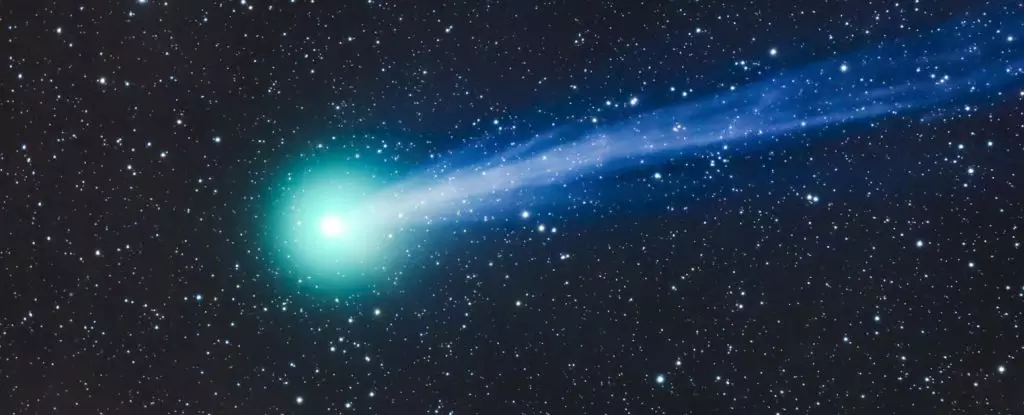The recent observations of the interstellar comet 3I/ATLAS have ignited both excitement and curiosity within the astronomical community. This alien traveler, hurtling through our solar system at an extraordinary speed, presents a chemical profile that defies traditional cometary expectations. What makes 3I/ATLAS especially intriguing is its subtle yet puzzling green hue, a characteristic usually associated with specific molecules fluorescing under solar radiation. However, the composition data tell a different story: a lack of the common green-emitting molecule, C2, which raises profound questions about the comet’s true nature and origin.
This discrepancy isn’t merely a minor anomaly; it challenges our understanding of comet chemistry and how interstellar objects might differ from the native comets we’ve studied for decades. The realization that 3I/ATLAS’s green glow could stem from an unexpected molecule or an altogether different chemical process encourages us to reconsider the diversity of organic and inorganic compounds that can survive and manifest in rogue celestial bodies. It suggests that interstellar objects might carry chemical signatures not only unlike those of our solar system’s comets but possibly more diverse and complex than previously thought. This could have significant implications for theories around the formation of planetary systems and the distribution of organic materials across the galaxy.
The Mystery of the Missing C2 and the Power of Depleted Chemistry
One of the most compelling puzzles involves the apparent absence of the molecule dicarbon (C2), traditionally responsible for the distinct green emission in many comets. Yet, observational data—including spectra and imaging—have failed to conclusively detect C2 in 3I/ATLAS. This is extraordinarily unusual because, in typical comets, C2 is abundant enough to dominate the green fluorescence, lit up vividly when the comet’s ices vaporize under solar heat. The fact that it’s missing here suggests that we are dealing with a comet whose chemical makeup has undergone extraordinary processing or originated from a different environment altogether.
Adding to this enigma is the discovery that cyanogen (CN) molecules are present in substantial quantities. Ironically, the presence of cyanogen indicates a depletion of the usual carbon chain molecules like C2 and C3, setting 3I/ATLAS apart as potentially one of the most depleted carbon-chain comets ever observed. This chemically “stripped down” composition could imply that the comet’s parent body formed in a region of space with conditions that favored the retention of certain molecules over others, or that the comet has undergone interactions that altered its initial makeup.
This chemical peculiarity may reflect conditions in interstellar space vastly different from those in our solar system’s formation zones. The possibility that 3I/ATLAS’s observed green glow is produced by an alternative molecule or a complex organic compound opens a window into new chemical processes that may occur in cold, distant regions of the galaxy. It underscores the importance of not taking standard comet chemistry as a universal rule but instead recognizing the diversity and complexity inherent in cosmic bodies originating beyond our solar neighborhood.
Implications for Interstellar Exploration and Future Discoveries
The case of 3I/ATLAS exemplifies the significance of studying interstellar objects, not only as curiosities but as potential keys to understanding the wider universe. Unlike our familiar solar system comets, interstellar visitors come with a backstory written in chemical signatures that are often unfamiliar and unexpected. If the green hue is caused by molecules other than C2, or if it results from some other process altogether, it could redefine what we know about the materials that traverse interstellar space and are eventually captured by star systems.
Furthermore, the peculiar composition of 3I/ATLAS might hint at different pathways of planetary and comet formation existing in other parts of the galaxy. This could mean that the organic and inorganic inventories of these interstellar wanderers are far more varied than our solar system’s, potentially carrying unique molecules that could seed life elsewhere or shed light on the chemical evolution of planetary systems.
The December approach of 3I/ATLAS to Earth promises a wealth of data that could finally unravel these mysteries. As telescopes and spectrometers become more sophisticated, the ability to detect faint signals from such enigmatic objects grows. The hope is that upcoming observations won’t merely confirm existing theories but will lead to new paradigms about the formation of celestial bodies, cosmic chemistry, and the diversity of planets and comets across the universe.
In the end, 3I/ATLAS isn’t just a visitor from afar; it is a catalyst for scientific revolution, reminding us that the universe harbors secrets far beyond our current grasp, waiting for curious minds to uncover and understand them.

